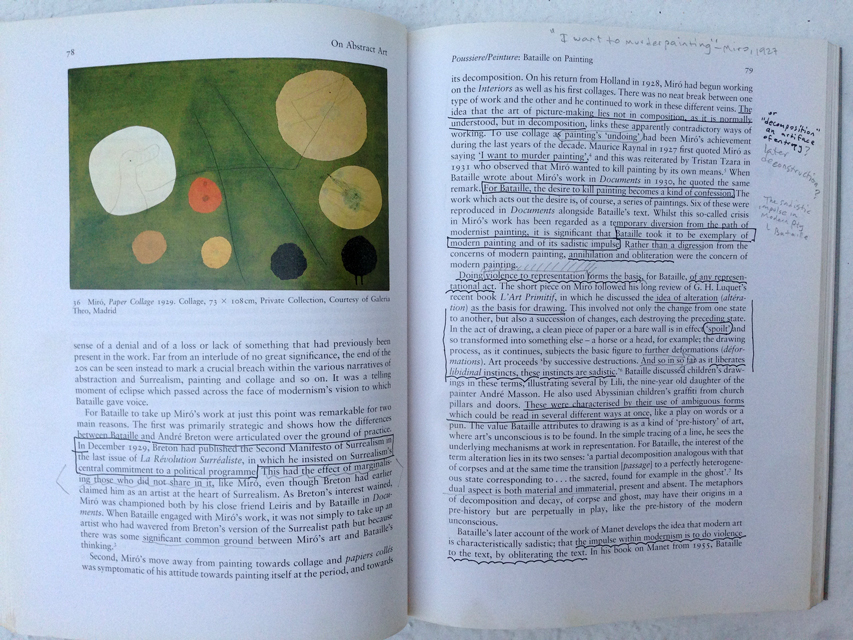July 9, 2015
Recent Preoccupations

Three notes and comments follow:
1. Before I left NYC, I met up with David Rhodes in Chelsea for a tour of the galleries. Along the way (right after we saw the remarkable exhibit of Lee Lozano at Hauser & Wirth which put her legendary renunciation of art -read: painting- in contrast to a body of astoundingly refined abstract paintings), David mentioned Joan Miro's desire to murder painting. I shouldn't have been surprised by this early statement of the death of painting meme. Instead, I should have been reminded since I had read about this years ago in Briony Fer's "On Abstract Art", a copy of which I have here in Tossa. I picked it up again this summer and took a pencil to add to the annotations that I had already scrawled into the book (I invoke the practice of Nabokov as an authoritative precedent in my defense to potentially horrified book lovers).
Why didn't I internalize this fact into my ideas about the emergence of the postmodern from the high modern (NY school of AbEx painting, late 50's) already? (For a fast reference, see this blogpost, read after "...the hazard we risk") I have held two potentially opposing thoughts aloft and unreconciled. On one hand, the postmodern succeeded the high modern with a deft inversion of its operating principals (where once artists attempted to touch G-d via material means, afterwards they pointed to everyday life via conceptual means). On the other, I have always believed that the modern and postmodern was born Janus-faced as one (this idea bloomed when I read Roger Shattuck's "The Banquet Years", especially when he focused on Jarry's antics), only to diverge completely as the 60's dawned. When I struggled to map the ideological roots of the "death of painting" meme, I should have kept in mind the deep roots of negation in modern art.
2. Late nights in the studio with Paul Berman in the ear buds:
In Western tradition, there exists a place for skepticism and doubt. These two attitudes, skepticism and doubt are elements of faith, the elements that prove the authenticity of belief in G-d. The G-d of the Old Testament instructs Abraham to sacrifice his son Issac, and Abraham doubts the instruction and struggles to resist it for a little while. And Abraham 's doubt and his struggle testify to the sincerity of his belief.-Terror and Liberalism, Paul Berman (2004)
3. Late nights in the studio with Beethoven in the ear buds:
Beethoven, Eroica (The Symphonies of Beethoven, Robert Green, 1996)
From motives, Beethoven develop themes, from these he develops permutations and rhythmic expressions of which these are manipulated and combined with geometric plasticity. Negation (inverted and nested contrary themes) and affirmation (combinatorial and lyrical themes) are in tension and are worked in concert (no pun intended) in his compositions.
Assorted comments:
Joan Miro wanted to murder painting. He ended up growing and amplifying painting.
Andre Breton: "The simplest of surrealists acts is to going down into the street, revolver in hand and shooting randomly into a crowd."
Bataille almost entered the seminary, and afterwards rebelled to carnal depths. After reading the snip from Berman above, one could accept that the extremities of Bataille's imagination was a testament to his sincerity of his (eventual) belief in G-d.
When did we start accepting things only at face value and not for the underlying reality implied? When did we lose touch with the function of artifice in argument?
Weren't Miro and Bataille aware of the artifice of their argument? Of course they were. (Bataille was pushing back on the looming fascism of his time.) Associations, metaphors, images and allusions that were enlisted in Bataille's writing were not meant to be taken literally, even though their indulgence went to extremes. Breton was not radical enough for Bataille. Bataille and his circle of friends once called themselves "Acephale" and went to the brink of voting amongst themselves as to which one was to be beheaded as an expression of the dismemberment that symbolized the violence of collage. They idealized an absolute liberty, past the point of nihilism but as long as this was in service in the realm of art, artifice was pushed to the limit in the service to aesthetics.
Strange that, the instrumentalization of violence for creative ends. The Dadaists were said to have been so repelled by the shock, gore and irrationality of the First World War that they based the aesthetic of the succeeding era on shock, gore and irrationality. Somehow, I can't buy that assertion at face value. The best response to existential exposure is to serve healing and re growth, not to throw a tantrum. Unless that is, carthesis is part of the prescription. Catharsis is __________. Even so, carthesis is but a momentary event, one very hard to sustain in time. Get it out of your system any way you can, but afterwards wash your face and take stock of your situation.
I think that in those post war years both WW I & II, negation was still yoked to affirmation, that George Groz, for example, made wonderful paintings from the most horrific images is only one of a multitude of testaments to the truth of this. This yoke has crumbled in recent art history, and what has remained with us is a peculiar unquestioned idea that art is negation, and only negation.
Painting is wonderful as the closed set that yields the possibility of the open set. In oil painting, you have two opposed and deliberately complimentary material actions: the binding force of oil and the dispersive force of solvent. How was it that some (or even most) of us have come to see only the dispersive force as the only possible future for art?
Posted by Dennis at July 9, 2015 5:39 AM
Leave a comment